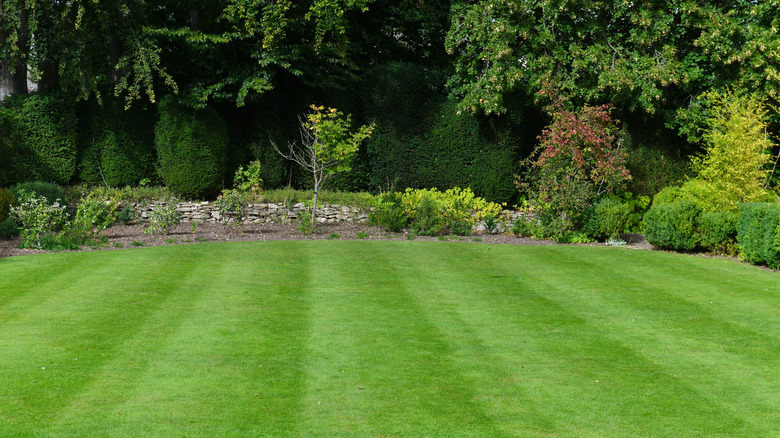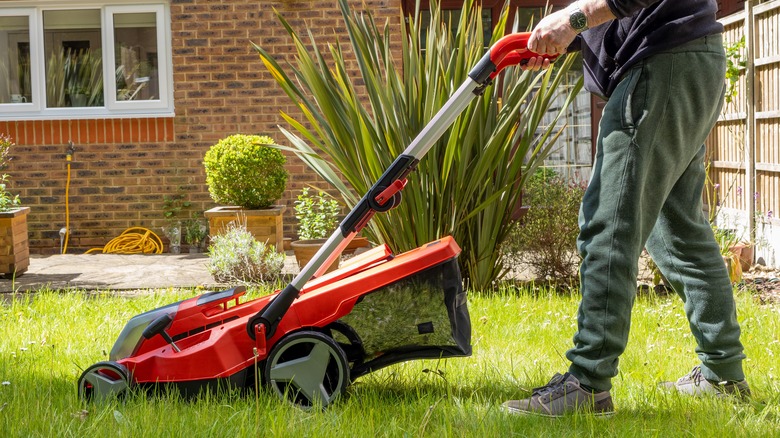Here's Why You Should Be Striping Your Lawn
When you think of the perfect lawn, neatly manicured grass often comes to mind. But have you considered going a step further? Introducing striping into your garden routine can take your lawn's aesthetics to a whole new level. Indeed, striping your lawn is a great idea — this method of lawn maintenance makes the grass appear healthy and well-maintained; it also brings a touch of sophistication and visual delight to your garden, rivaling the appeal of professional golf courses. Whether you're aiming to enhance your property's curb appeal, express your creativity, or simply take pride in a well-maintained lawn, striping offers a straightforward and rewarding method to achieve these goals.
So how exactly does lawn striping work? To put it simply, the technique involves alternating mowing directions to create a patterned effect. While mowing your lawn, you can bend grass blades in different directions. When the sunlight shines on the grass, blades bent towards you appear darker, while those bent away look lighter. Placed side by side, this creates a striking visual contrast of alternating light and dark stripes, adding a bold, aesthetically pleasing effect to your lawn. It's also worth noting that striping is merely a visual effect and does not harm the grass in any way. While it may sound complex, you can adopt a simple technique with the right approach and tools. Beyond its aesthetic appeal, lawn striping can offer a few additional benefits that might surprise you.
Benefits of law striping
The primary reason to start striping your lawn is the visual interest it creates. This patterned effect instantly adds depth and dimension to your landscape, making your lawn stand out in the neighborhood. The stripes can be manipulated to create various designs, from simple parallel lines to checkerboard patterns, waves, or even your unique creation. The beauty of lawn striping is that it allows you to get creative with your lawn without the need for additional landscaping elements. With just the simple act of mowing in different directions, you can turn your lawn into a canvas and make your own artistic statement.
Furthermore, a well-striped lawn can significantly enhance your property's curb appeal. If you're considering selling your property, a beautifully striped lawn can create a positive first impression for potential buyers. It signals that the homeowner pays attention to detail and invests time in maintaining the property. This subtle cue may impact how your property is perceived and increase its value.
Beyond the aesthetic aspect, striping your lawn has significant health benefits for your grass. Changing your mowing direction also prevents soil compaction in specific areas. When soil becomes compacted, it restricts the movement of water, air, and nutrients through the soil, which can significantly affect plant growth, according to North Carolina State University.
How to stripe your lawn like a pro
Creating that sophisticated striped pattern on your lawn is simpler than you might think. Here's how you can transform your yard into a visually appealing landscape. Firstly, invest in a lawn mower with a striping kit attached. The lawn striper rolls over the grass after it has been cut, bending the grass blades in the direction you're mowing. When you turn around and mow in the opposite direction, the grass blades bend the other way. This creates alternating light and dark stripes.
Plan your striping pattern ahead of time. Simple patterns, like straight lines or checkerboards, are the most commonly used. To create straight lines, look ahead of you when mowing and aim for a fixed point at the end of the lawn. This ensures you're moving in a straight line. For a checkerboard pattern, mow the lawn a second time at a 90-degree angle to your first pass.
Keep in mind that the striped appearance is a result of the way sunlight reflects off the bent grass blades. Try to consider the primary viewing angle when planning your pattern for the best visual effect. Depending on your preference, this is often from the house or the street.


